

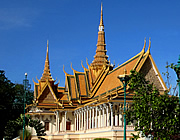
At the confluence of three rivers, including the mighty Mekong, Phnom Penh is a busy city with a beautiful palace and temples and surprisingly impressive Art Deco.
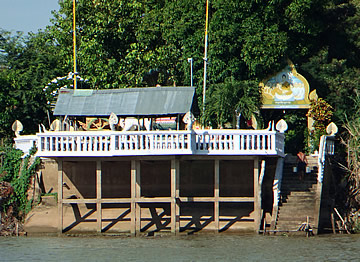
We arrived in Phnom Penh by speedboat up the Mekong River from Chau Doc in Vietnam - a great way to enter the city. The river itself is fascinating and I never tired of looking at life on and along the water. Our pilot was very good, making a point of going closer to the river banks where he could so that we could see some of the more interesting things such as stilt villages and fish farms.
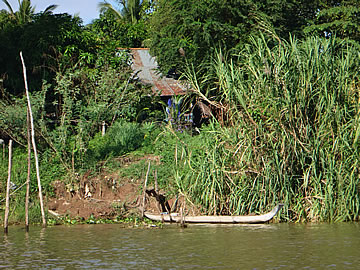
Not long after leaving the Vietnamese customs post, which was housed in a rather bleak building, we stopped for Cambodian customs in altogether more pleasant surroundings. Many of the officials were working at outdoor tables under a shady canopy in the lush gardens.
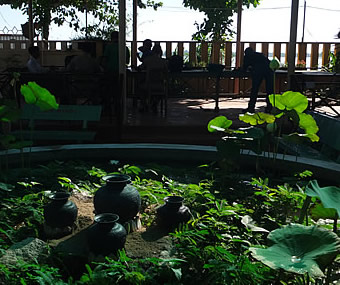
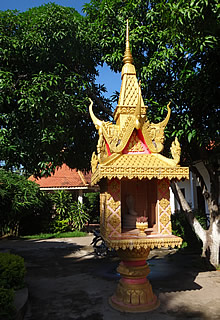
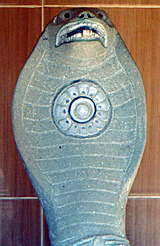
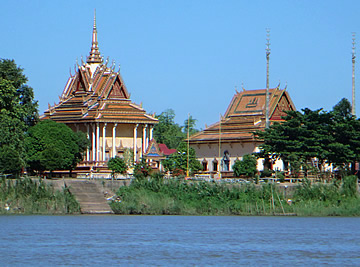
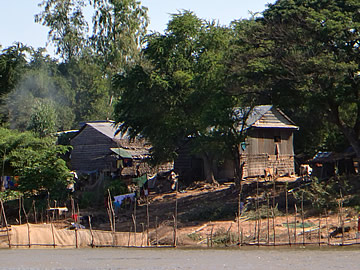
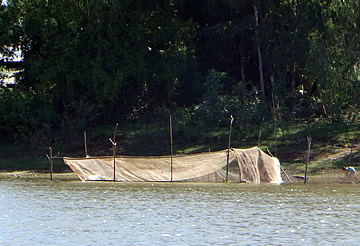
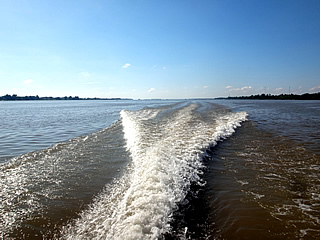
Fishing is going on all along the river, from small boats to netted enclosures near the shore.
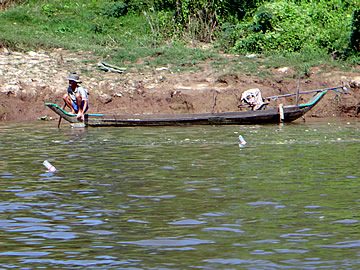
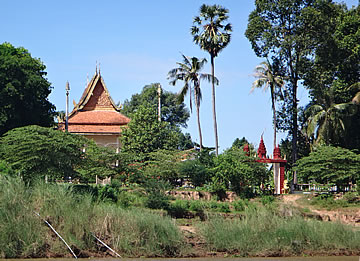

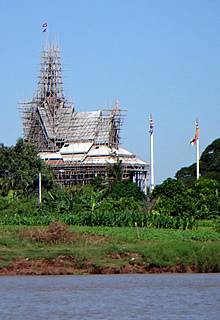
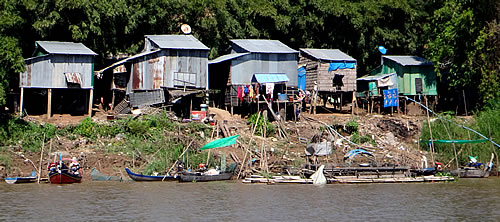
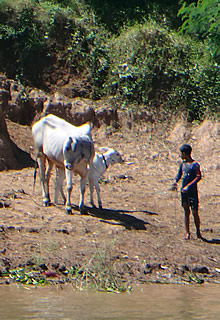
The river life seems much the same whether in Vietnam or Cambodia, apart from the white cattle we saw here.
As we approached Phnom Penh there were more signs of industry and a few commercial ships. We arrived at 12:15 to be whisked away to our hotel, White Mansion, and a beautiful, large airy room.
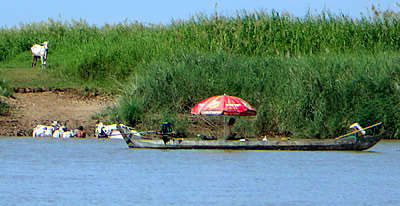

After lunch in the bakery attached to the hotel (excellent spring rolls!) and a siesta, we decided to go for walk in the city. It wa around 3pm and still very busy with a lot of traffic.


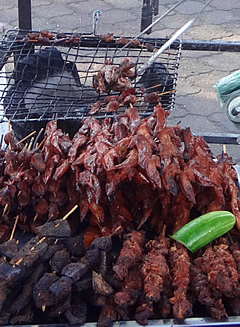
All the streets are numbered. The White Mansion is on 240 which runs roughly east-west. We headed east towards the Mekong, passing the Royal Palace complex - elephants feature strongly on the surrounding fence!

Over the road here is the ornate Supreme Court building, looking very like a temple to my eyes.

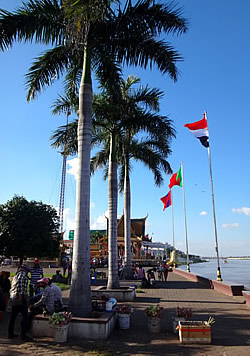
The Cambodian capital moved many times in the early centuries of the country's history. Phnom Penh became the capital in 1866 in the reign of King Norodom I and has remained the capital ever since.
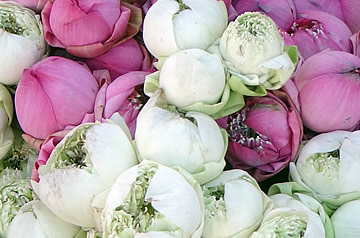
For centuries Thailand and Vietnam fought for control of the Cambodian kingdom. This was brought to an end in 1864 by the signing of a treaty of Protectorate with the French who later negotiated the return of areas from Thai control, including Siem Reap and Angkor. In 1953 King Norodom Sihanouk declared Cambodian independence.
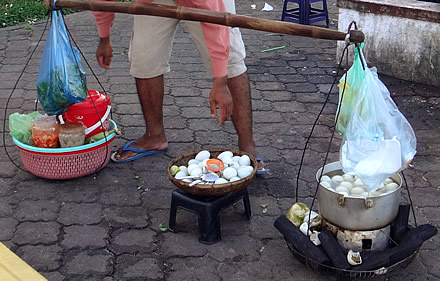
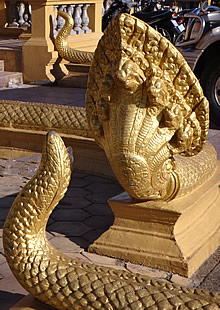
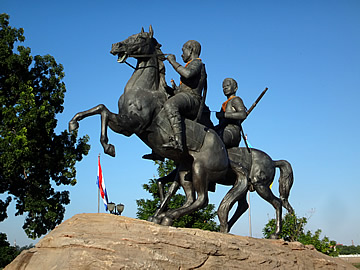
Recent history has been less kind to Cambodia. The neighbouring Vietnam war spread into Cambodia and in 1970 Sihanouk was overthrown by General Lon Nol and retreated to Beijing, allying himself with the so-called Khmer Rouge. The Khmer eventually took Phnom Penh in 1975 and so began a devastating time for the Cambodian culture as they set about destroying as much of the past as possible, replacing it with a peasant-based agricultural economy. The people suffered terribly, no-one was spared the back-breaking work in the fields. So-called intellectuals were targetted for death - simply wearing spectacles was regarded as a symbol of intellectualism. The ruthless regime, led by the infamous Pol Pot, was eventually brought down by the Vietnamese in 1979.
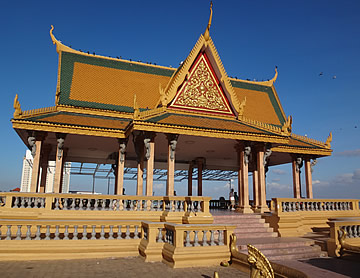
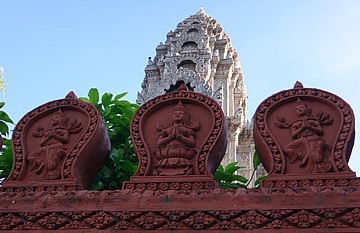
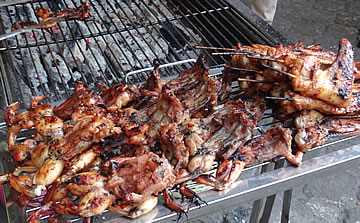
We turned left to head north on Sisowath Quay - the Mekong, Bassac ad Tonle Sap rivers meet at Phnom Penh. We passed many street food vendors and the Royal Palace complex, temples and ornate riverside buildings, some probably shrines and access points to the river from the palace.
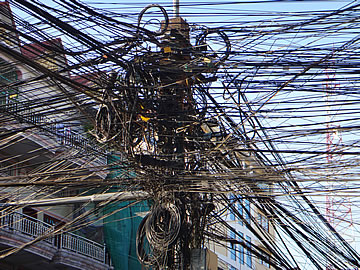
A grilled bird was obviously very popular and we saw this being cooked and sold by many street vendors using anything from small grills to full-blown rotisseries!
We had very good cold draught beers at KWest before walking back through the city streets. The city is equally fascinating at night which we discovered later when we went out for dinner - a meal to forget at Malis where the duck was dry and the service very poor. We would probably have been better off with the street food!
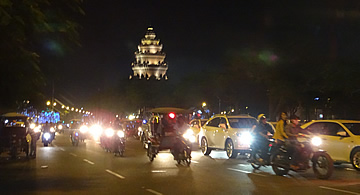

The Royal Palace is a Khmer-style complex, built in the nineteenth century, and reminded us of the palace in Bangkok. The roofs are particularly beautiful.
As the home of the Cambodian Royal Family much is not open to the public. No photography is allowed in the Throne Hall or SIlver Pagoda.
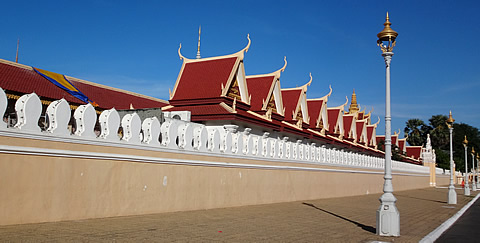
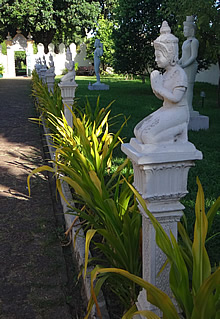
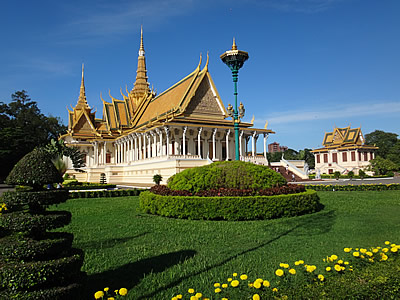
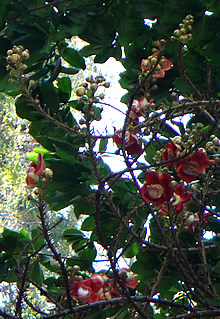
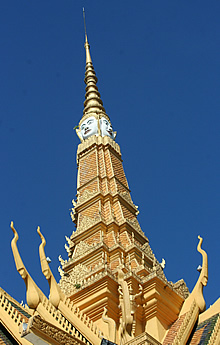
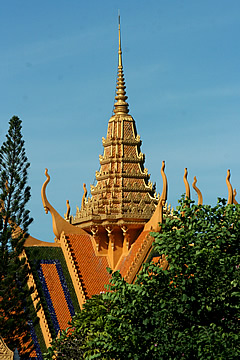
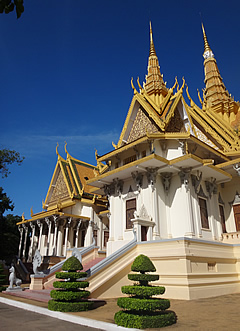
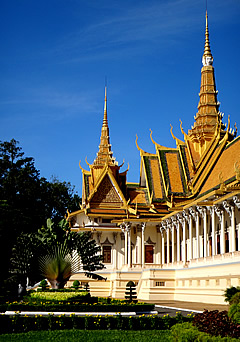
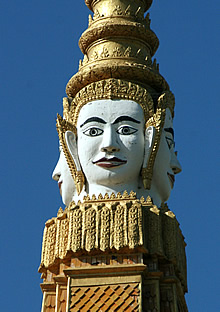
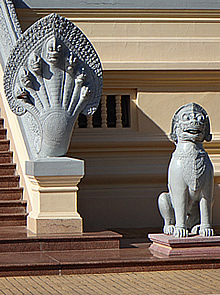
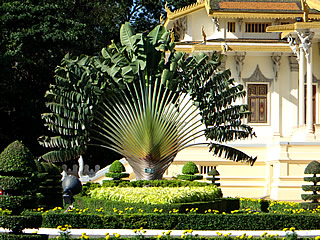
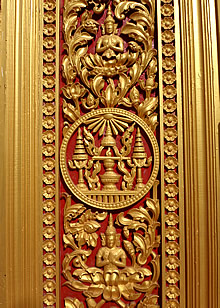
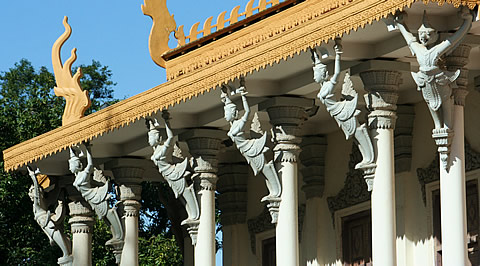
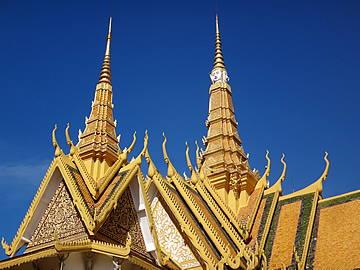
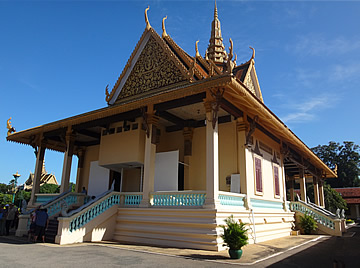
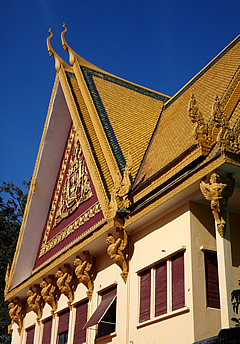
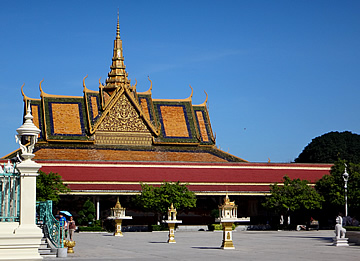
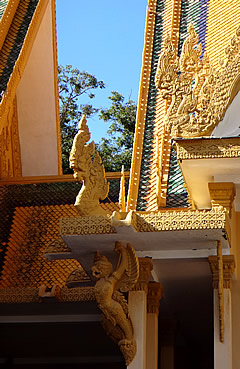
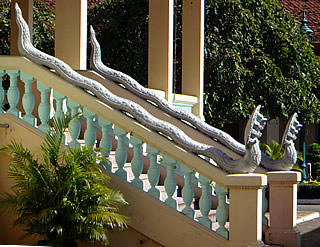
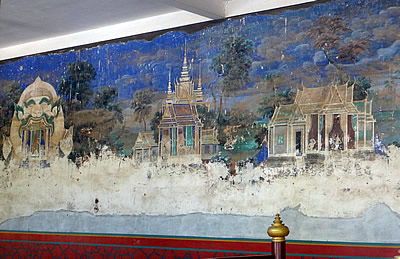
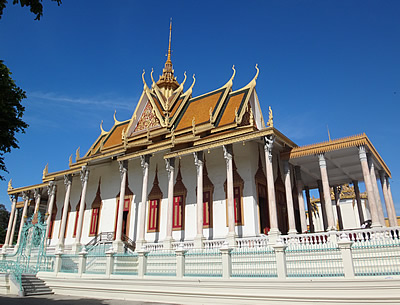
The Silver Pagoda complex of buildings is a paved area just south of the palace, surrounded by a wall.
The Silver Pagoda gets its name from the silver tiles which cover the floor. It is also known as the Temple of the Emerald Buddha as, alongside many treasures, it houses a small green crystal Buddha statue.
No photography is allowed inside the Silver Pagoda itself.
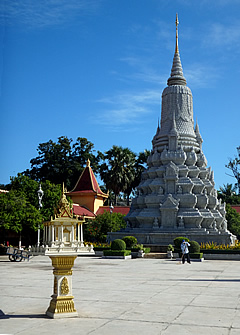
There are several stupas in the Silver Pagoda complex - stupas are Buddhist memorial monuments. Here they are all dedicated to members of the royal family.
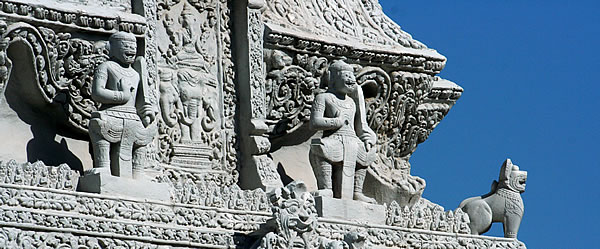
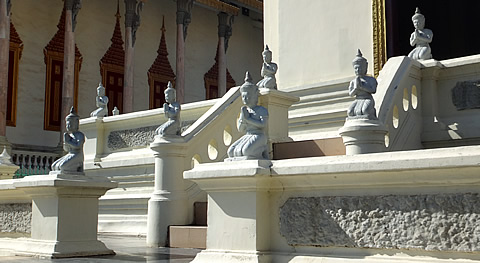
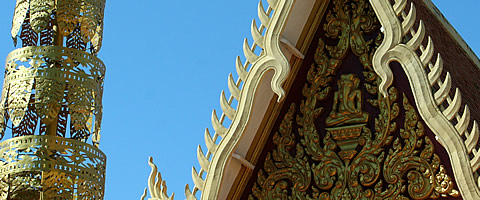
At the extreme south end of the Silver Pagoda complex is an exhibition hall. It has some interesting items including a traditional Khmer stilt house and a huge white elephant.
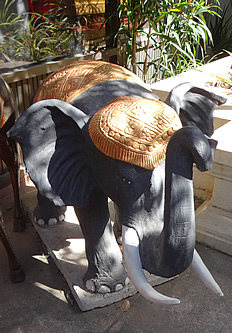
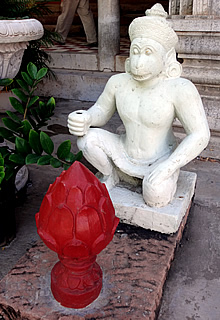
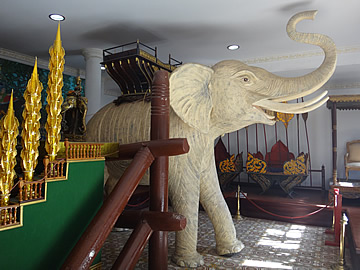
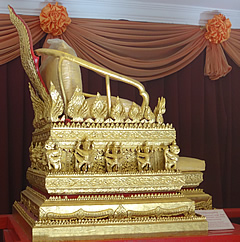
Hinduism and Buddhism are equally important in Cambodian culture which is why representations of many Hindu gods, as well as Buddhist artefacts, can be seen in museums.
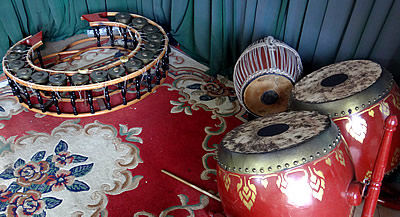
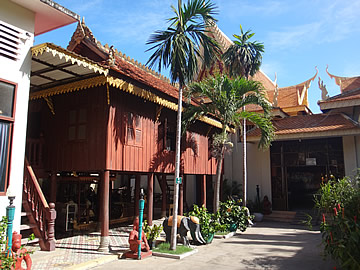
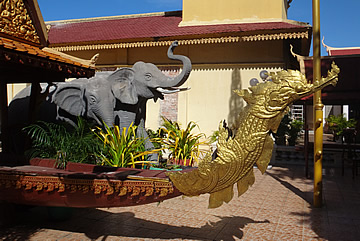
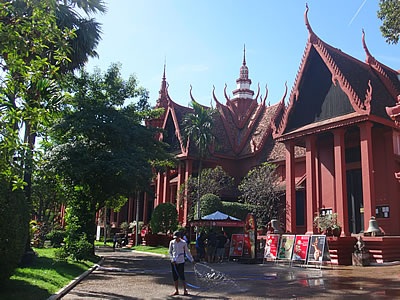
The National Museum is housed in a twentieth century Khmer-style building close to the Royal Palace. It is a treasure house of traditional Cambodian art and culture.
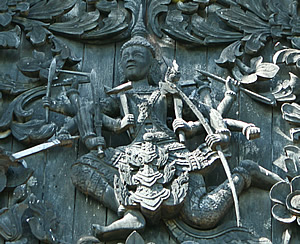
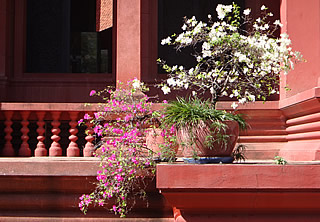
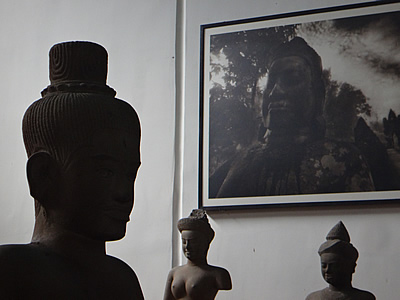
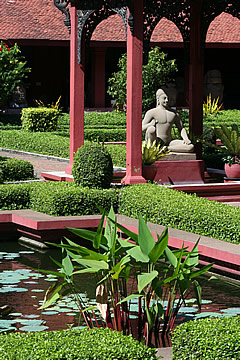
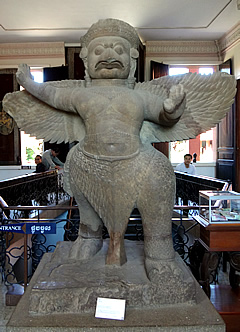
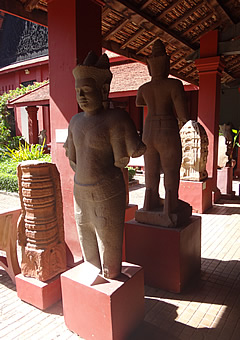
The museum is set around a lush courtyard and is a very pleasant place to wander.
The collection illustrates well the two religions - Hinduism and Buddhism - which are traditional to the country, with many fine temple statues.
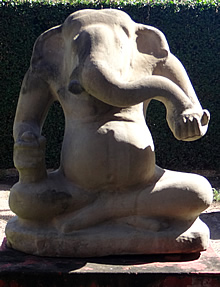
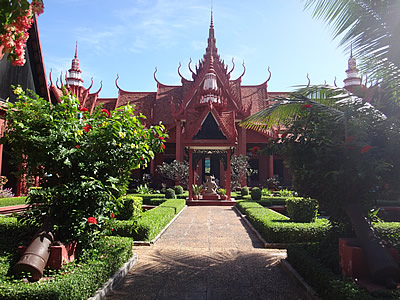


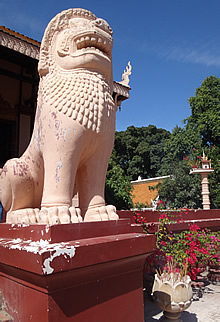
Wat Phnom is the city's first pagoda said to have been erected in 1373 to house four statues of Buddha found by a woman called Penh in the river. She had originally created a shrine for them on a small hill which became the site of Wat Phnom.
The temple has wonderful guardian lion statues and impressive naga balustrades.
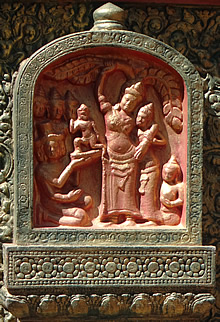
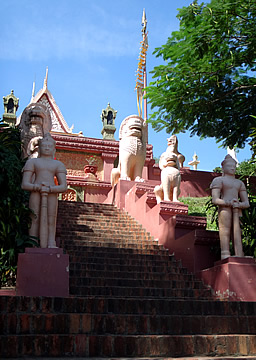
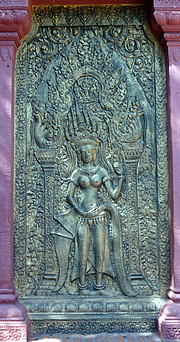
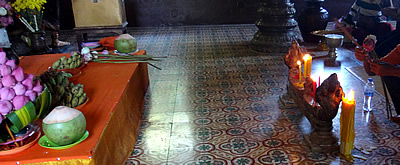
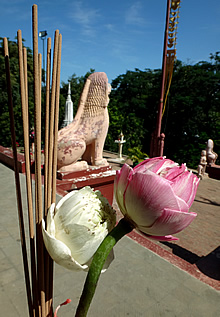
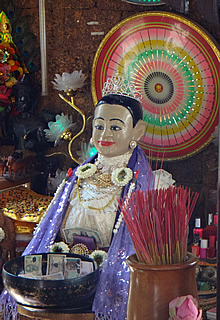
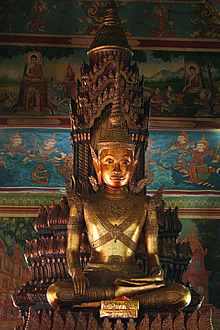
I paid $1 for an incense bundle, candle and lotus flowers to give to our guide so that he could show us the procedure of offering at the shrine. It is all very dignified and reverential.
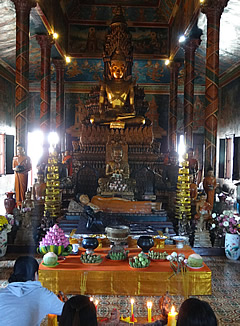
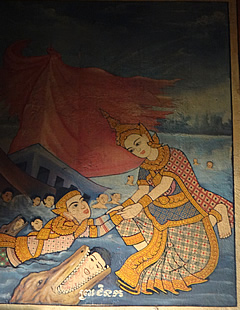

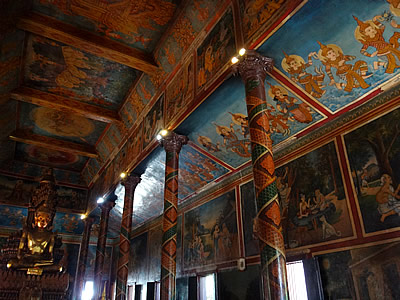
The temple is beautifully painted, some murals show scenes from the life of the Buddha others are from the Reamker.
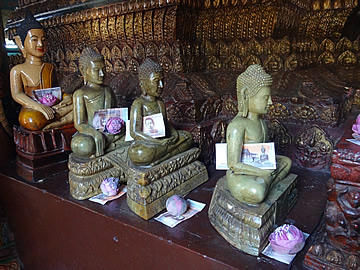
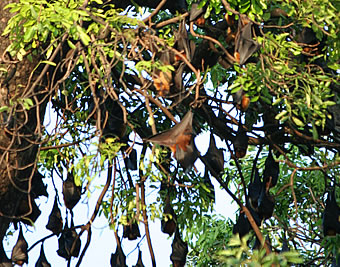
Outside I paid another $1 to free two swifts - many local people were doing this, it is supposed to bring good luck. We had wondered what all the wire cages holding birds were there for. I could feel the hearts of the two tiny birds beating as I held them in my hands before launching them into the air - I wish I could have set all the caged birds free.
Later in the day we happened to be again at Wat Phnom and saw that hundreds of large bats were hanging from the trees nearby. These are flying foxes or fruit bats.

We had been scheduled to take a Living History tour of Phnom Penh but somewhere along the line there was a mix-up and the young man who turned up was a guide for the architecture of the city. We worked out an itinerary between us, which mostly followed his normal route. He was a recent architecture graduate, passionate about his subject, and knowledgeable about the history to. This turned into a really fascinating tour - we would never have learned so much nor visited such out-of-the-way places otherwise.
We explored an area to the east and north of Wat Phnom, the Old Quarter. Before establishment of the French Protectorate it would all have been wooden buildings here. The French started to build in stone. Apparently there is not a great deal of French colonial architecture remaining in the city, and some of that is in a terrible state.
We began, however, at the Post Office, which is in a good state of repair. Built in 1895 the interior is now completely changed, but columns and basic structure, such as where interior doors had been, remain in place. Originally it had louvered windows to control the air flow and light.

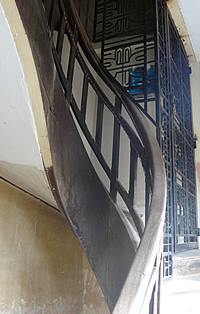
Across from the Post Office is a rather dilapidated building that had once been a first class hotel, the French colonial Hotel Manolis. Built in 1910 it is now in a very sorry state.
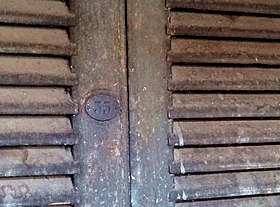
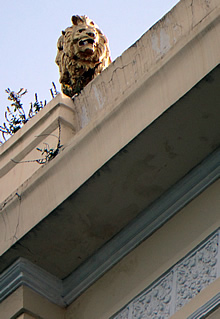
We followed our guide up a curving staircase - it had obviously been quite fine at one time - and he showed us the original room doors, still with their numbers, and, across an interior courtyard, the back of another building, once the 1890 Grand Hotel.
The Hotel Manolis was at least being put to some use: several families live here, though the conditions looked squalid.
We walked around the back of the Manolis to see what remains of the Grand. The building, on Sisowath Quay facing Tonle Sap River, appears to be intact, home to a KFC on the ground floor, and seems to have been recently painted. Only remnants of moulding and sad lions on the roofline give any idea of what it might once have been, though.
Our guide then took us to a beautiful Taoist temple in the Chinese quarter.
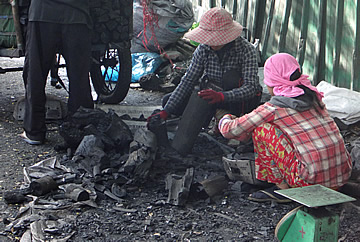
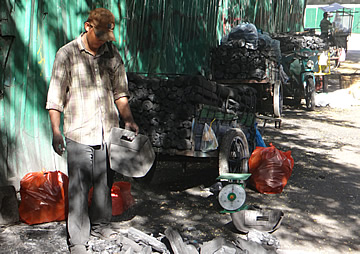
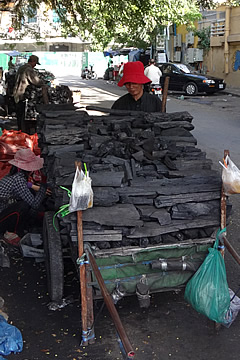
On the way we passed a group of charcoal sellers - the people use it as fuel for cooking. It's very dirty, the sellers hands were black with it.
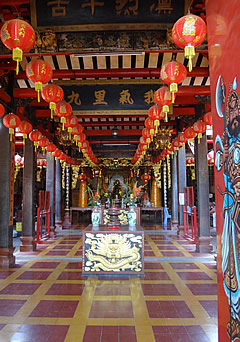
The Xie Tian Gong temple dates from 1880 and is one of the few reminders of the once-flourishing Hokkien Chinese population of the city.2 It was the only temple to survive the destructions of the Khmer Rouge.
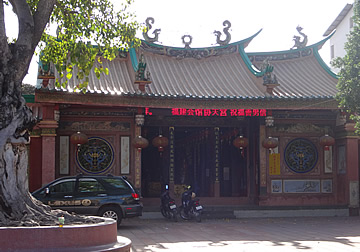
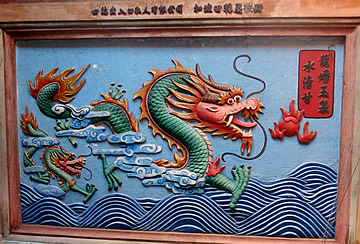
The door into the temple is set in a frame so that you have to look down to make sure you don't trip - a neat device to ensure humility as you enter the temple - and for good luck you must enter on the right and leave on the left.
Inside it is brilliantly coloured with statues, strings of Chinese lanterns suspended from the ceiling and depictions of white tigers and dragons symbolising physical and spiritual aspects of the world - yin and yang.3
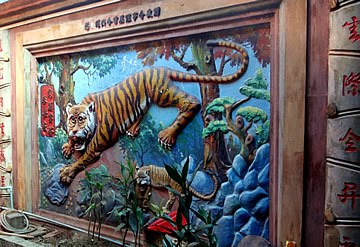
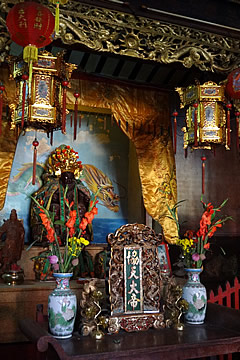
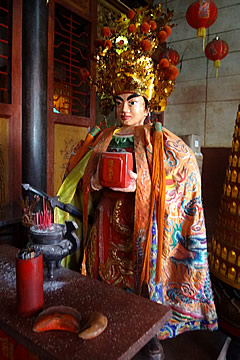
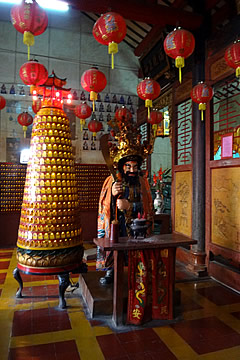
There are colourful statues of Taoist deities and a fortune-telling area by the altar. Our guide demonstrated how it was performed. A cylinder of wooden sticks is shaken and one falls out. Each stick is numbered and racks of cards interpret each number.
To determine whether this is the correct answer to your question you must then throw the two parts of the yin and yang, teardrop-shaped blocks with one curved side and one flat side. If one lands on the flat side and one on the curved side then the answer is correct.
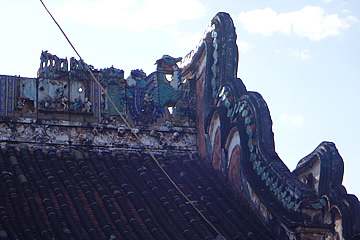
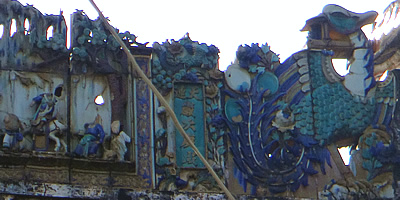
Leaving the temple our guide took us through narrow alleys where the people live clustered around the Jade Mountain Taoist temple of which very little remains, only carvings on the roof and high up inside the roof space hint at its former splendour.
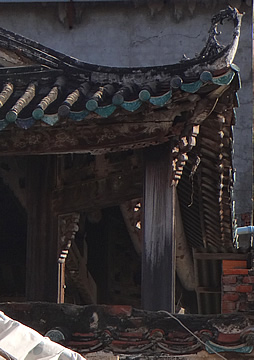
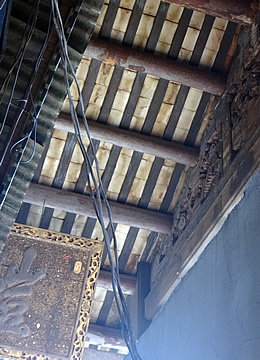
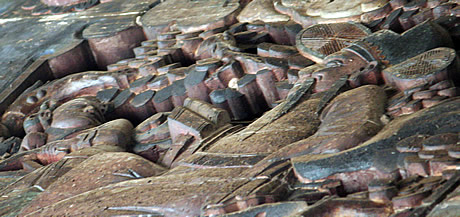
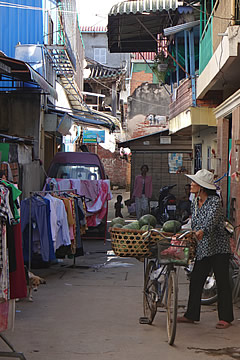
A pattern of severe neglect of old buildings was beginning to emerge, and the next was just as bad.
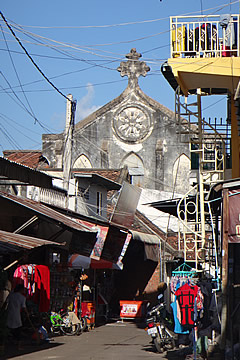
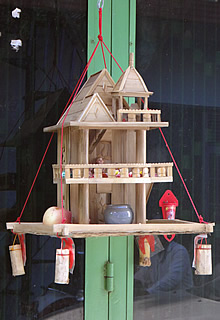
We passed through more alleys where families were living in crowded conditions. It was a holiday for the Water Festival so a lot of people were at home, many playing cards on the floor, the doors open to catch any breeze. Usually there would be boat races on Tonle Sap to celebrate the festival but these had been cancelled, not for the first time. The given reason was low water levels, but in reality it was probably due to a fear of political unrest.
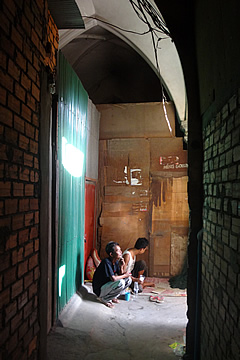
Our guide said we were lucky it wasn't going on as the city is impossible to get around during festival celebrations with millions of people coming to see the races. Still, the races must be great fun to see. Luckily races were taking place in Siem Reap while we were there.
The Chapel of the Sisters of Providence Hospice dates from around 1900 and is completely abandoned by the order, now practically falling down and providing living space for many families. It was hard to believe families were living in such cramped conditions.
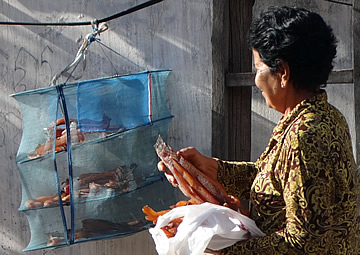
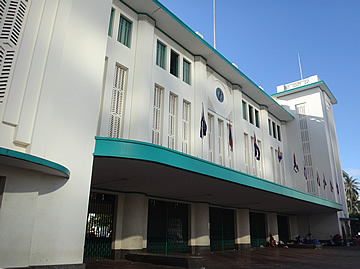
On to a couple of Art Deco gems - first the 1932 Central Railway Station. This lovely building is now little used and our guide said that it was to be sold into private hands and would probably soon be gone. However, in 2016 limited train services between Phnom Penh and Sihanouk Ville began so maybe the station has gained a new lease of life.
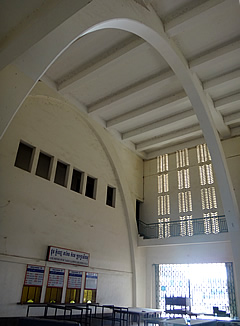
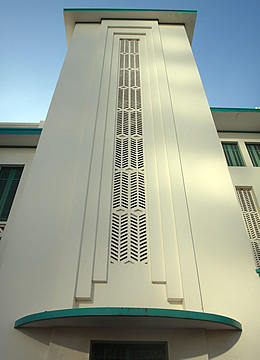
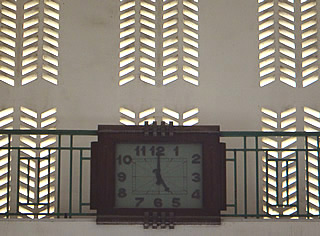
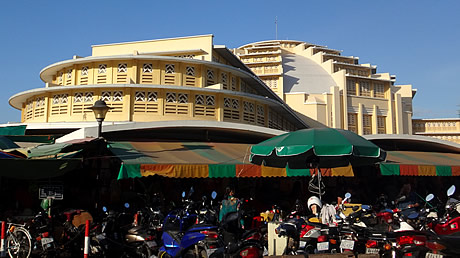
And so to our final architecture stop, the magnificent Central Market, a very fine example of Art Deco. Built in 1937 it is a large dome with four radiating arms, all filled with market stalls. Inside the decoration is also classic art deco.
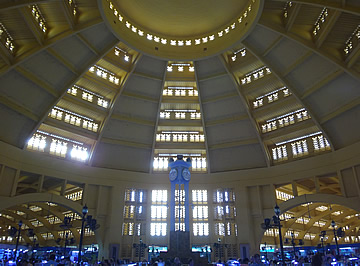
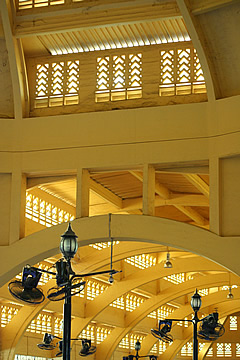
All manner of things are sold here from high end jewellery to children's toys.
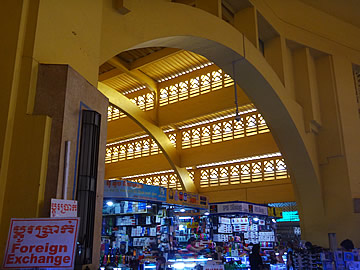
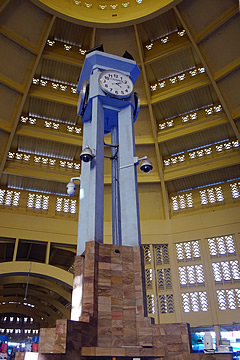
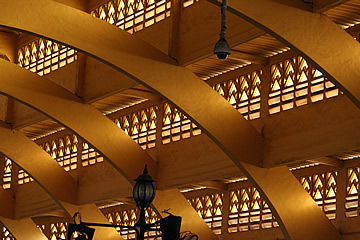
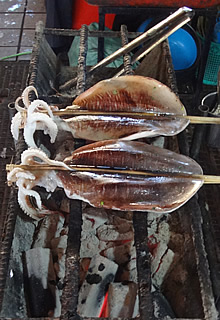
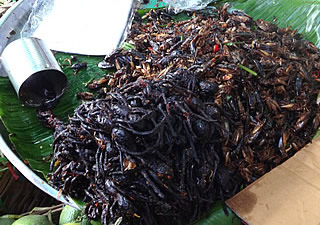
Around the outside are numerous food vendors and many people eating or buying food to take home. Amongst all the fresh fruit, noodle, shellfish, etc. were more exotic items such as deep-fried spiders and large grilled octopus! I was going to try the spiders but they really didn't look very appetising at all.
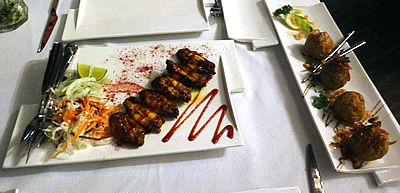
On the way back to the hotel we passed more dilapidated colonial structures and our guide pointed out more of architectural interest including a high school, but the temples, alleys and Art Deco buildings were definitely the highlights of this tour.
We rounded off the day with an excellent meal at Kaviar, a Persian restaurant a short walk from our hotel. Though there is no street lighting in this part of the city the light spilling from the lively cafes and shops is sufficient to see by. Our meal was superb, the service excellent, and the restaurant itself beautiful.